On 20 November 1944, Flight Sergeant Phillip Smith and his crew were detailed to bomb an oil refinery at Homberg, Germany. Flying in Lancaster JN-V (serial number ND911) they took off from RAF Mepal at 12:43 hrs for an unusual daylight raid. They must have felt quite confident, as this Lancaster had flown 70 operations, at a time when the average life of a Lancaster was only five operations. Neither was this a rookie crew. They had flown on 21 operations, including Stettin, Duisburg, Essen, Koblenz and Dortmund, and targets in occupied France and Holland. They had survived a flak hit over Saarbrucken, and battled with night fighters on several occasions. They looked well set to complete their tour of 30 ‘Ops’.
Phillip Francis Smith was born in Subiaco, Western Australia, on 21 March 1924, the son of World War I veteran Arthur Joseph Smith and Irene Elizabeth Smith (nee Minogue). Phillip was the third of nine children and grew up in Maylands, where he and his mate Jack Meyer enjoyed many escapades. Phillip attended Perth Boys School, leaving in 1938 to work as an optical mechanic.
In November 1941, he enrolled in 78 Squadron (Guildford) Air Training Corps, and on turning 18, he enlisted in the RAAF on 25 May 1942. After initial training at Clontarf, Perth, he trained as a wireless operator/air gunner on CAC Wacketts at Ballarat, and Fairey Battles at West Sale. With the award of his Air Gunner Brevet, Phillip was given embarkation leave, as he was destined for the UK and Bomber Command. It was the last time his family would see him.
On 30 August 1943, Phillip sailed on the USS West Point from Melbourne to Auckland and across the Pacific to San Francisco. He then travelled by train to New York, where he and his fellow airmen went sightseeing and enjoyed a few beers in the Golden Palms, Broadway. Of the four of them, Eric Silbert was the only one known to survive the war. He flew two operational tours, joined the Pathfinders and was awarded the DFC. After the war, he became Deputy Lord Mayor of Perth and was awarded the AM.
The airmen departed New York on 1 October aboard the four-funnel RMS Aquitania, designated Convoy AT65. On 7 October a German submarine was sunk nearby, and they were attacked by a four-engine Luftwaffe Condor, which veered off after return fire.
After disembarking at Greenock, Scotland on 9 October 1943, Phillip travelled by train to Brighton, where new arrivals were billeted at the Grand or Metropole Hotel. There was time to explore London, visit Australia House and the Boomerang Club, and there were dances, and cosy English pubs.
Further training followed on the Marconi radio in Avro Ansons at RAF Llandwrog, Wales. Then at 12 Operational Training Unit, Chipping Warden, he crewed up on the twin-engine Wellington, with pilot Patrick ‘Leo’ McCartin, navigator John Miles, bomb aimer Len Martin, and tail gunner John Gray. The crew progressed to 1657 Heavy Conversion Unit at Shepherds Grove, Suffolk, where they were joined by flight engineer William (Bill) Warlow, and mid-upper gunner Dennis Bryer. After training on the four engine Stirling, they advanced to No. 3 Lancaster Finishing School at RAF Feltwell.
They were now operational, and on 14 August 1944, they were posted to 75 (NZ) Squadron at Mepal, near Ely, Cambridgeshire. Over the next three months they went on to become one of the Squadron’s most experienced and respected crews. On the 29 August, on a raid to Stettin, they fought off a JU88 night fighter, and two days later, they bombed the V1 flying bomb supply dump at Pont Remy. Then on their ninth ‘Op’ they bombed the railway centre at Saarbrucken, but were hit by flak and diverted to RAF Woodbridge, where Len Martin souvenired some of the shrapnel. On 19 October the crew bombed Stuttgart, as logged by tail gunner John Gray, ‘Attacked by JU88 twice in succession. Two good combats.’
On 10 November, the crew along with their ground crew honoured the 70th operation of JN-V (Victor), proudly posing alongside the Lancaster’s nose with its 70 bomb symbols. However, on 20 November 1944, on their 22nd operation, luck ran out for crew and aircraft.
After take-off from Mepal, they set course for Homberg and the oil refinery, which was situated near Duisburg at the confluence of the Rhine and Ruhr rivers. The weather was overcast and stormy, and the force of 183 Lancasters could not hold formation. Although very few Luftwaffe fighters came up, the Ruhr Valley lived up to its name (Happy Valley) with very heavy flak. Nevertheless, all went well until approaching the target. Tail gunner Sergeant John Gray recalls the final moments of JN-V and her crew:
On the bombing run up, we were forced to lose height through engine trouble in the starboard outer. The trouble forced us to feather the motor. A few minutes later at 1515 hrs we dropped the bombs, according to the bomb aimer, all the H.E. [high explosive] left the aircraft. About five minutes later the port wing burst into flames. No order was given by the captain, F/O P L McCartin, to abandon aircraft. By this time the aircraft was in a very violent spin during which I was knocked unconscious. When I came to, the entire tail unit had broken off from the fuselage. I then got out of the rear turret and baled out from approx 10,000 feet. On the way down I saw nothing to indicate anything of the other crew members having baled out. About 2,000 feet I was fired on by light gunfire. I was not hit … when I landed pieces of aircraft were still falling, giving a strong indication that the aircraft had blown up in mid-air.
SGT Gray was taken prisoner by a soldier who took him to a flak battery near Orsna. He was treated by a German doctor who told him that two crew members had been found dead in the wreckage. The next day Gray was taken to a night fighter base, and after three days he was sent to Dulag Luft, the POW interrogation camp near Frankfurt. He was the only survivor from the crew.
Phillip Smith was dead, at just twenty years old. Neither he nor William John Warlow, John Miles or Dennis George Albert Bryer could be individually identified and were buried in a collective grave, with individual headstones, in Rheinberg War Cemetery, north-west of Duisberg. Patrick Leo McCartin and Leonard Arthur Martin were buried in Reichswald Forest War Cemetery, Kleve. Phillip was initially listed as missing, and the family clung to the hope that he was still alive, but a year later Phillip’s death was presumed to have occurred on 20 November 1944.
In 1949, the Missing Research and Enquiry Service excavated the Lancaster wreckage in Baerler Busch, a small forest north-west of Homberg.
For many years, Phillip’s family placed memoriam notices in the West Australian. Then on 25 June 2005, Phillip’s sister, Gwen, dedicated a memorial plaque in Kings Park, Perth. Neither was Phillip forgotten by the next generation. On every anniversary of his death, nephew Jim Smith and family attend the plaque, while Phillip’s niece Helen, has marched on Anzac Day, wearing his medals.
by Charles Page
Sources:NAA, Smith P F, Service Record, Casualty File.
Picture: 75(NZ) Squadron ORB, Eric Silbert memoirs, J Smith records















